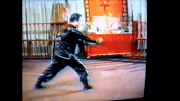Damien
Blue Belt
So I've been thinking about how to frame this for a while. When a lot of people outside the kung fu sphere, or even certain styles or relative beginners think of animals and kung fu, its in terms of performance forms. There's a lot more to the references to animals within many styles though than just trying too look like the animal. Monkey Steals Peach has talked about how the whole Manits wobble thing is a modern stylistic invention for example:
I'm often frustrated by people claiming that Northern Shaolin is all about imitating animals. You see it on TV, on the websites of schools that practice animal styles etc. Yes there are performance forms, but mostly that's not what Shaolin is. It does draw inspiration from animals in the illustrative naming of techniques and principles though. The names are meant to encapsulate and help explain the idea. I don't have the same knowledge of other styles, but I expect the same is true with many.
I wanted to try and get this idea across to people, and also provide some valuable training tips, and ideas for the use of certain types of technique all in one package. After a few different ideas and rewrites, I finally came up with an angle. So, here are some ways in which Shaolin references tigers, and how you can put this stuff into use. I hope you find it interesting, and hopefully useful (if you ever suffer from dodgy knees, I can't recommend the Patrick Step enough).
I'm often frustrated by people claiming that Northern Shaolin is all about imitating animals. You see it on TV, on the websites of schools that practice animal styles etc. Yes there are performance forms, but mostly that's not what Shaolin is. It does draw inspiration from animals in the illustrative naming of techniques and principles though. The names are meant to encapsulate and help explain the idea. I don't have the same knowledge of other styles, but I expect the same is true with many.
I wanted to try and get this idea across to people, and also provide some valuable training tips, and ideas for the use of certain types of technique all in one package. After a few different ideas and rewrites, I finally came up with an angle. So, here are some ways in which Shaolin references tigers, and how you can put this stuff into use. I hope you find it interesting, and hopefully useful (if you ever suffer from dodgy knees, I can't recommend the Patrick Step enough).

